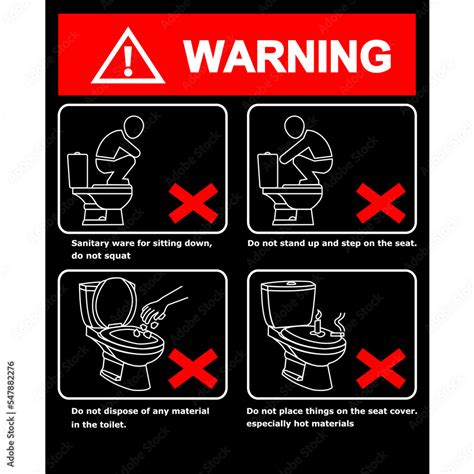
Carnival Cruise Line is cautioning passengers against flushing anything other than toilet paper down onboard toilets, emphasizing the potential for significant plumbing issues and service disruptions if this guideline is ignored. The cruise line is actively educating passengers about the specific items that should never be flushed, reinforcing the importance of proper waste disposal to ensure the smooth operation of its ships.
Carnival Cruise Line has issued a comprehensive warning to passengers regarding acceptable bathroom practices onboard its ships, specifically addressing what items should never be flushed down the toilets. This initiative aims to prevent plumbing problems that can lead to onboard disruptions and potentially impact the cruise experience for all passengers. The company is taking a proactive stance by educating guests about the proper disposal of waste materials, underlining the sensitivity of the ships’ plumbing systems.
The advisory emphasizes that only toilet paper should be flushed. Items such as sanitary products, paper towels, wipes (even those labeled as “flushable”), diapers, cotton balls, and any other foreign objects can cause severe blockages. According to Carnival, these items do not break down in the ship’s plumbing system as toilet paper does, leading to clogs and potential damage. “To help us keep the ‘fun’ in your vacation, we ask that you avoid flushing anything other than toilet paper,” the cruise line stated in its advisory. This simple request is vital for maintaining the functionality of the ship’s waste management systems.
The consequences of flushing inappropriate items can be substantial. Blockages can lead to overflowing toilets, backed-up plumbing, and unpleasant odors, which can affect not only the cabin where the issue originates but also neighboring cabins and public areas. Addressing these problems requires significant time and resources from the ship’s crew, potentially leading to delays in service and inconvenience for passengers. In some cases, severe blockages may even necessitate repairs that could take the ship out of service for a period of time, impacting future cruises.
Carnival Cruise Line is implementing various measures to educate passengers about proper flushing practices. These include placing informational notices in cabins, displaying reminders in public restrooms, and providing verbal instructions during onboard announcements and safety briefings. The cruise line aims to ensure that all passengers are aware of the guidelines and understand the importance of adhering to them. By promoting responsible waste disposal, Carnival hopes to minimize plumbing issues and maintain a clean and comfortable environment for everyone onboard.
The cruise line also underscores the environmental considerations associated with improper waste disposal. Items that are flushed down the toilet but do not break down can end up in the ocean, contributing to marine pollution and harming wildlife. By adhering to proper flushing practices, passengers can help protect the marine environment and support the cruise line’s sustainability efforts. Carnival is committed to responsible environmental stewardship and encourages passengers to join in these efforts.
The move by Carnival Cruise Line reflects a broader trend in the cruise industry to address the challenges of waste management and environmental impact. As cruise ships become larger and carry more passengers, the demands on their onboard systems increase, making it even more critical to ensure that these systems are properly maintained and operated. By educating passengers and implementing responsible waste disposal practices, cruise lines can reduce their environmental footprint and provide a more sustainable cruise experience.
Carnival’s warning also serves as a reminder that while modern cruise ships offer many of the comforts and conveniences of land-based accommodations, they operate in a unique environment with specific infrastructure requirements. The plumbing systems on cruise ships are designed to handle certain types of waste, and introducing foreign objects can disrupt their functionality. By being mindful of what is flushed down the toilet, passengers can contribute to the smooth operation of the ship and help ensure a pleasant cruise experience for themselves and others.
The cruise line also encourages passengers to report any plumbing issues they encounter to the ship’s crew immediately. Addressing problems promptly can prevent them from escalating and causing more significant damage. By working together, passengers and crew can maintain the ship’s systems and ensure a comfortable and enjoyable cruise for everyone.
Carnival Cruise Line’s dedication to passenger education and responsible waste management is a testament to its commitment to providing a high-quality cruise experience while minimizing its environmental impact. By adhering to the guidelines and working with the ship’s crew, passengers can play a vital role in maintaining the functionality of the ship’s systems and protecting the marine environment.
In-Depth Analysis and Context
Carnival Cruise Line’s initiative to educate passengers about proper flushing practices is a crucial aspect of responsible cruise ship operation. The relatively confined and complex nature of a cruise ship’s plumbing system makes it highly susceptible to blockages caused by inappropriate waste disposal. Unlike municipal sewage systems on land, which are designed to handle a wide range of materials, cruise ship plumbing systems are specifically engineered to process human waste and toilet paper. The introduction of other materials can quickly overwhelm the system, leading to significant problems.
The potential consequences of plumbing blockages on a cruise ship are far-reaching. Beyond the immediate inconvenience of an overflowing toilet or a backed-up sink, blockages can disrupt the ship’s entire waste management system. This can lead to unpleasant odors in cabins and public areas, as well as potential health hazards. In severe cases, blockages can even damage the ship’s plumbing infrastructure, requiring costly repairs and potentially taking the ship out of service.
The impact on passengers can also be significant. A plumbing problem in one cabin can easily affect neighboring cabins, disrupting their occupants’ cruise experience. The ship’s crew may need to spend considerable time addressing the issue, which can divert resources from other tasks and potentially delay services. In extreme cases, passengers may even need to be relocated to other cabins while repairs are underway.
The environmental implications of improper waste disposal are also a major concern for cruise lines. Items that are flushed down the toilet but do not break down can end up being discharged into the ocean, contributing to marine pollution. Plastics, in particular, pose a significant threat to marine life, as they can be ingested by animals or entangle them, leading to injury or death. Cruise lines are under increasing pressure to reduce their environmental footprint and promote sustainable practices, and responsible waste management is a key component of these efforts.
Carnival Cruise Line’s proactive approach to passenger education is a positive step in addressing these challenges. By providing clear and concise information about proper flushing practices, the cruise line empowers passengers to make informed decisions and contribute to the smooth operation of the ship. The use of multiple communication channels, including informational notices in cabins, reminders in public restrooms, and verbal instructions during onboard announcements, ensures that the message reaches a wide audience.
The cruise line’s emphasis on the specific items that should never be flushed is particularly important. Many passengers may not realize that even products labeled as “flushable” can cause problems in cruise ship plumbing systems. These products often do not break down quickly enough and can accumulate in the pipes, leading to blockages. By explicitly stating that only toilet paper should be flushed, Carnival clarifies the expectations and helps prevent misunderstandings.
The cruise industry as a whole is becoming increasingly aware of the importance of responsible waste management. Many cruise lines have implemented comprehensive waste management programs that include recycling, composting, and advanced wastewater treatment systems. These programs are designed to minimize the environmental impact of cruise ship operations and promote sustainability. Passenger education is an essential component of these programs, as it helps ensure that waste is properly sorted and disposed of.
Carnival Cruise Line’s warning also highlights the need for passengers to be mindful of the unique environment of a cruise ship. While cruise ships offer many of the comforts and conveniences of land-based accommodations, they operate in a self-contained environment with limited resources. Passengers need to be aware of the impact of their actions on the ship’s systems and take steps to minimize their footprint. This includes not only proper waste disposal but also conserving water, reducing energy consumption, and respecting the ship’s environment.
In conclusion, Carnival Cruise Line’s initiative to educate passengers about proper flushing practices is a vital aspect of responsible cruise ship operation. By providing clear information, promoting responsible waste disposal, and addressing the environmental implications of improper practices, the cruise line is taking a proactive step in ensuring a smooth, comfortable, and sustainable cruise experience for all passengers. This initiative also underscores the broader trend in the cruise industry towards responsible waste management and environmental stewardship.
Expanded Context and Background Information
The issue of proper waste disposal on cruise ships is more complex than it might initially appear. Cruise ships are essentially floating cities, generating significant amounts of waste that must be managed responsibly. The waste management systems on cruise ships are designed to handle a variety of waste streams, including sewage, solid waste, and hazardous waste. Each of these waste streams requires specific treatment and disposal methods.
Sewage, also known as black water, is the wastewater generated from toilets and urinals. Cruise ships are equipped with advanced wastewater treatment systems that are designed to remove pollutants from sewage before it is discharged into the ocean. These systems typically use a combination of physical, chemical, and biological processes to treat the wastewater to meet strict environmental standards. However, these systems are not designed to handle solid waste, such as sanitary products or wipes.
Solid waste includes garbage, recyclables, and other non-hazardous materials. Cruise ships typically have onboard facilities for sorting and processing solid waste. Recyclables are separated and stored for later disposal at port. Garbage is either incinerated onboard or offloaded at port for disposal in landfills. The incineration of garbage can reduce its volume and generate energy, but it also produces air emissions that must be controlled.
Hazardous waste includes items such as used batteries, fluorescent lamps, and chemicals. Cruise ships are required to manage hazardous waste in accordance with international regulations. This typically involves storing the waste in designated containers and offloading it at port for proper disposal.
The improper disposal of any of these waste streams can have significant environmental consequences. Sewage that is not properly treated can contaminate the ocean and harm marine life. Solid waste that is dumped into the ocean can pollute beaches and entangle marine animals. Hazardous waste can contaminate the environment and pose a threat to human health.
Cruise lines are under increasing pressure to improve their waste management practices and reduce their environmental footprint. This pressure comes from a variety of sources, including environmental organizations, regulatory agencies, and passengers. Many cruise lines have responded by implementing comprehensive waste management programs that include:
- Waste Reduction: Reducing the amount of waste generated onboard through measures such as using reusable containers and reducing packaging.
- Recycling: Separating and recycling materials such as paper, plastic, and glass.
- Composting: Composting food waste and other organic materials.
- Advanced Wastewater Treatment: Using advanced wastewater treatment systems to remove pollutants from sewage.
- Proper Waste Disposal: Disposing of waste in accordance with international regulations.
- Passenger Education: Educating passengers about proper waste disposal practices.
Carnival Cruise Line’s initiative to educate passengers about proper flushing practices is a key component of its overall waste management program. By preventing solid waste from entering the sewage system, the cruise line can reduce the load on its wastewater treatment systems and minimize the risk of environmental pollution.
The issue of “flushable” wipes is a particular concern for cruise lines. These wipes are often marketed as being safe to flush down the toilet, but they do not break down quickly enough in sewage systems and can cause blockages. Many municipal sewage systems have also experienced problems with “flushable” wipes, leading to costly repairs and increased maintenance. Cruise lines are increasingly discouraging passengers from flushing “flushable” wipes and urging them to dispose of them in the trash.
The design of cruise ship plumbing systems also plays a role in the issue of waste disposal. Cruise ship plumbing systems are typically more complex and sensitive than those found in land-based buildings. This is due to the limited space available on ships and the need to conserve water. Cruise ship toilets often use vacuum systems to flush waste, which can be more susceptible to blockages than traditional gravity-based systems.
The maintenance of cruise ship plumbing systems is also critical to preventing problems. Cruise lines typically have dedicated teams of engineers and plumbers who are responsible for inspecting and maintaining the ship’s plumbing systems. Regular maintenance can help identify and address potential problems before they become major issues.
In addition to educating passengers, cruise lines can also take other steps to prevent plumbing problems. These include:
- Installing screens and filters in toilets and drains to prevent solid waste from entering the system.
- Using enzymes and other additives to help break down waste in the sewage system.
- Regularly cleaning and inspecting the plumbing system.
- Training crew members on proper waste disposal practices.
By taking a comprehensive approach to waste management and plumbing maintenance, cruise lines can minimize the risk of plumbing problems and protect the environment. Passenger education is an essential component of this approach, as it empowers passengers to make informed decisions and contribute to the smooth operation of the ship.
The Role of Technology and Innovation
Advancements in technology are playing an increasingly significant role in improving waste management practices on cruise ships. Innovations in wastewater treatment, waste-to-energy systems, and automated waste sorting are helping cruise lines to reduce their environmental footprint and operate more sustainably.
Advanced wastewater treatment systems are becoming more sophisticated, capable of removing a wider range of pollutants from sewage. Some cruise ships are now using membrane bioreactor (MBR) technology, which combines biological treatment with membrane filtration to produce high-quality effluent. MBR systems can remove virtually all solids and bacteria from sewage, making it safe to discharge into the ocean.
Waste-to-energy systems are also gaining popularity on cruise ships. These systems use various technologies to convert waste into energy, such as incineration, gasification, and pyrolysis. Incineration is the most common waste-to-energy technology used on cruise ships, but gasification and pyrolysis are becoming more attractive options due to their lower emissions. Waste-to-energy systems can reduce the volume of waste that needs to be disposed of and generate electricity or heat that can be used to power the ship.
Automated waste sorting systems are helping cruise lines to improve their recycling rates. These systems use sensors and robots to sort waste materials, such as paper, plastic, and glass, more efficiently than manual sorting. Automated waste sorting systems can also identify and remove contaminants from the waste stream, improving the quality of the recycled materials.
The use of data analytics is also helping cruise lines to optimize their waste management practices. By collecting data on waste generation, sorting, and disposal, cruise lines can identify areas where they can improve efficiency and reduce waste. For example, data analytics can be used to track the types of waste generated in different areas of the ship, allowing the cruise line to tailor its waste reduction efforts to specific areas.
The development and implementation of these technologies require significant investment from cruise lines. However, the long-term benefits, such as reduced environmental impact, lower operating costs, and enhanced reputation, make these investments worthwhile. Cruise lines are increasingly recognizing that sustainable waste management is not only the right thing to do but also a sound business practice.
FAQ Section
1. What items are specifically prohibited from being flushed down the toilet on Carnival cruise ships?
Carnival Cruise Line explicitly states that only toilet paper should be flushed. Prohibited items include sanitary products, paper towels, wipes (even those labeled as “flushable”), diapers, cotton balls, and any other foreign objects. These items do not break down properly in the ship’s plumbing system, leading to potential blockages.
2. Why is it so important to follow the flushing guidelines on a cruise ship?
Cruise ships have sensitive plumbing systems that are designed to handle only human waste and toilet paper. Flushing other items can cause severe blockages, leading to overflowing toilets, backed-up plumbing, and unpleasant odors. Addressing these issues requires significant time and resources from the ship’s crew and can disrupt the cruise experience for passengers.
3. What are the potential environmental consequences of flushing inappropriate items down the toilet on a cruise ship?
Items that do not break down properly can end up being discharged into the ocean, contributing to marine pollution. Plastics, in particular, pose a significant threat to marine life, as they can be ingested by animals or entangle them, leading to injury or death.
4. What measures is Carnival Cruise Line taking to educate passengers about proper flushing practices?
Carnival Cruise Line is implementing various measures to educate passengers, including placing informational notices in cabins, displaying reminders in public restrooms, and providing verbal instructions during onboard announcements and safety briefings.
5. What should I do if I encounter a plumbing issue in my cabin on a Carnival cruise ship?
Passengers are encouraged to report any plumbing issues they encounter to the ship’s crew immediately. Addressing problems promptly can prevent them from escalating and causing more significant damage.









